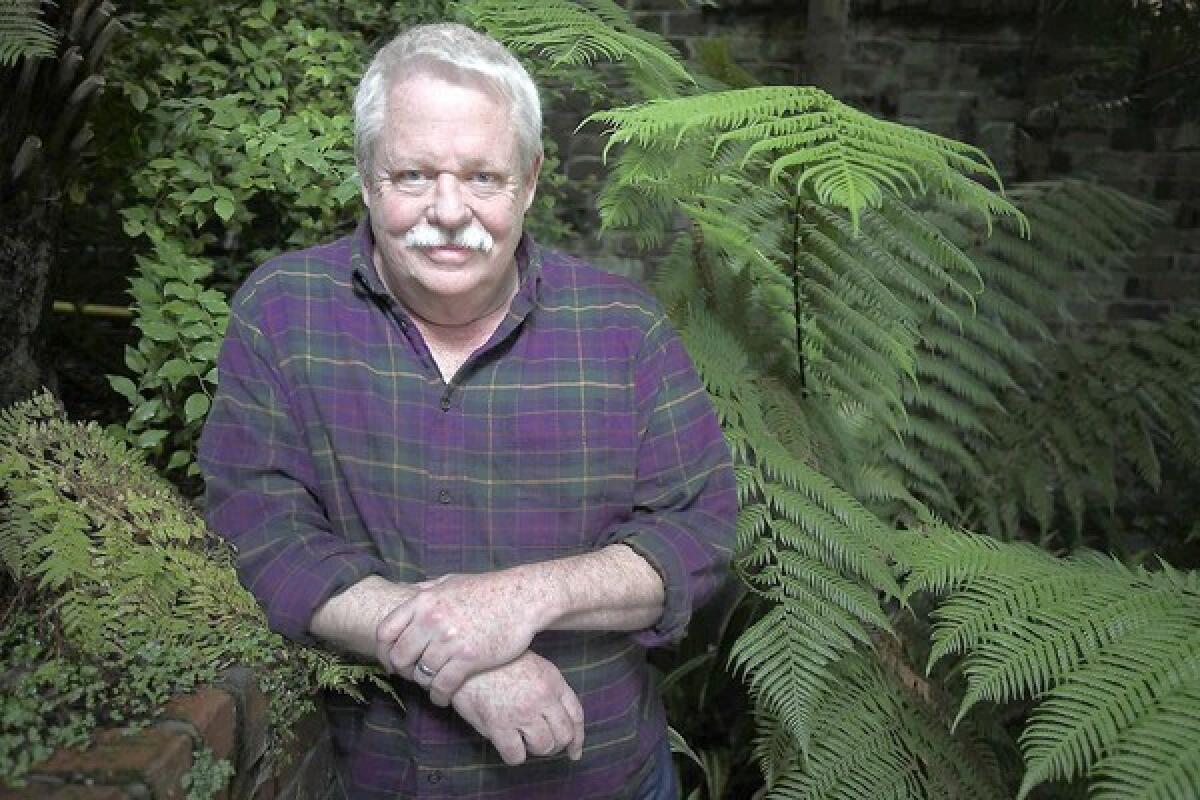Armistead Maupin’s quirky yet engaging characters still speak to him

Reporting from San Francisco —
The house that “Tales of the City” bought sits on the slope of a small hill not far from Golden Gate Park, tucked between Haight-Ashbury and the Sunset. It’s behind a gate, up a flight of outdoor stairs, greenery lush and a little wild. The atmosphere, one imagines, is akin to that of 28 Barbary Lane, the fictional Russian Hill apartment building where the first six of Armistead Maupin’s “Tales of the City” novels took place, magical and mysterious and full of history, much like San Francisco itself.
This, of course, has always been the point for Maupin, who began the saga in 1974 as a serial in the Marin County-based newspaper the Pacific Sun before moving it to the San Francisco Chronicle in 1976. Three and a half decades later, the characters he invented — Michael Tolliver, Mona Ramsey, Mary Ann Singleton and the irrepressible Anna Madrigal — have become part of the mythos of the city, their adventures re-created in three miniseries and commemorated on bus and walking tours.
“It’s an enormous privilege,” Maupin says, his voice still carrying the trace of a Carolina drawl after nearly four decades in the Bay Area, “to have created characters who are in the consciousness of readers who remember the history of those characters, and who can remember a time in their lives when those characters intersected with their own feelings.”
Maupin has long been something of an elder statesman, in both the literary and the gay community. “It’s very easy to forget now,” he reflects, sitting in his cozy front parlor, “how invisible gay life was 34 years ago. What I was watching, the flowering of this young culture and the personal liberation I was feeling, all became fodder for the work.”
And yet, at 66, he finds himself in a place that feels a lot like renewal; his new book, “Mary Ann in Autumn,” is the first full-fledged “Tales of the City” novel since “Sure of You” appeared in 1989.
It’s not that Maupin ever lost sight of his characters: There were those miniseries and some minor references in his 2000 psychological thriller “The Night Listener.” But in the wake of “Sure of You,” he immersed in other projects, including the Hollywood novel “Maybe the Moon” (1992), and it wasn’t until 2007’s “Michael Tolliver Lives” that he considered a full-scale return.
“I wanted to do a personal novel about a gay man who had survived AIDS,” Maupin says. “I realized I had just such a man in my repertoire and I decided that it would make sense to write through his eyes.”
Written in the first person and focusing primarily on a single character, “Michael Tolliver Lives” does not have the multi-voice quality of a true “Tales of the City” novel, Maupin insisted at the time. Now he acknowledges, “I was testing the waters to see how people felt about the series. What really drove me back was the urge to do that multi-character story line again.”
Equally important was the appearance of the saga’s other characters. “All the characters auditioned for me one at a time,” Maupin jokes. “I held off longest with Mary Ann. I was still a little grumpy about her. She got much nastier than I expected before I was finished with the series. Basically, I think, she was the incarnation of my darker, more ambitious side. And she was leaving San Francisco at the same time I was leaving the series. So I could talk about my own so-called betrayal in that way.”
Mary Ann has always been at the center of “Tales of the City”; the first book opens with her decision to stay in San Francisco, in the middle of an eight-day vacation, and the sixth ends as she, now a local TV talk show host, decamps to New York. It’s only fitting, then, that “Mary Ann in Autumn” should be the story of her reconnection — with the city, with her old friends, with herself.
“I wanted a little redemption,” Maupin says of her, “but not a tremendous amount.” The idea was to explore a more complex kind of reconciliation, in which old hurts can be forgiven but not entirely set aside.
Mary Ann is not without her own problems: She has ovarian cancer and is on the run from a failing marriage and a collapsed career. More than that, she is aware of all the people she has hurt, even if she doesn’t quite know how to make it right.
“The past doesn’t catch up with us,” she thinks at the beginning of the novel. “It escapes from us.” If “Tales of the City” was, initially anyway, a story of hope and possibility, “Mary Ann in Autumn” refracts those themes through the lens of aging, offering a more constrained view of the universe, in which certain things cannot be resolved.
That, to be sure, has always been part of the aesthetic; “I’ve never written an end in my life,” Maupin says with a laugh.
On the one hand, this is in the nature of a serial, which relies on a succession of cliffhangers, from episode to episode and book to book. For Maupin, it’s the fun and a necessary corollary to having written the first five novels for the newspaper, at the rate of five columns a week.
Yet even more than that, he points out, “You don’t wrap up life.”
Indeed, the “Tales” saga may be most remarkable for Maupin’s ability to reflect, through his characters, the open-ended world in which they live. “I came out in the serial,” he recalls. “Michael’s coming-out letter to his parents was my letter to my parents. They were subscribing to the Chronicle and I knew that they would know that I was talking about myself.”
Three books later, in “Babycakes” (1984), he began to write about AIDS.
The death of Michael’s lover, Jon Fielding, in that book was, Maupin notes, “the first AIDS fatality in fiction” and a source of considerable controversy. “A lot of gay people,” he remembers, “wrote me and said, ‘How dare you spoil our light morning entertainment with your personal agenda?’”
All these years later, Maupin is still mixing the personal and the political. Next May, San Francisco’s American Conservatory Theater will premiere a musical of “Tales of the City,” featuring, among other things, his coming-out letter set to song. Meanwhile, “Mary Ann in Autumn” appears to signal a new engagement with the serial. “It’s a little scary for me,” Maupin admits, “now that I feel committed to the notion of doing it for life.”
But why not? It’s a vivid time to be writing, with gay marriage a leading indicator of what Maupin calls “the great civil rights movement of the 21st century” and outreach efforts such as “It Gets Better” galvanizing a community.
“What makes the campaign so brilliant, so revolutionary,” he enthuses, “is that gay adults have behaved the way adults should behave towards kids, namely to lead the way. We’ve been afraid to do that for years because 30 years ago, Anita Bryant said gays are out to recruit your children. So everyone kept a respectful distance rather than simply acting as mentors and saying, ‘I know what it’s like, I was there.’”
More to Read
The biggest entertainment stories
Get our big stories about Hollywood, film, television, music, arts, culture and more right in your inbox as soon as they publish.
You may occasionally receive promotional content from the Los Angeles Times.







